New Social Market Options for Sustainable Urban and Regional Futures
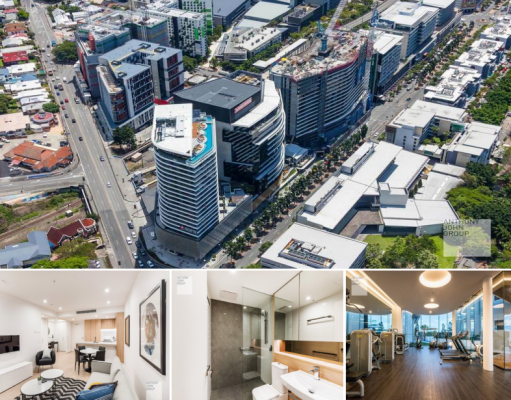
By Denis Bright
There is every reason to be hopeful about the future of South East Queensland (SEQ) through the implementation of the ShapingSEQ Regional Plan. The Plan is highly readable and does not require tedious editorial comments. This is a consensus-building document from the Queensland Government. The consensus extends to an involvement with the twelve local authorities in SEQ and even to the Smart Cities Plan of the federal LNP. The planning document is easily accessible online for readers who want to be inspired by good public policy which has been amended slightly after community feedback since the Draft Document in 2016.
The Queensland Labor Government has strived for goodwill from the Turnbull Government in the implementation of ShapingSEQ. The Australian Government’s own Smart Cities Plan sets out a more market-oriented vision for Australian cities, both metropolitan and regional.
The Queensland Government is committed to working with the Australian Government to establish and implement City Deals for Queensland under a memorandum of understanding (MOU) agreed to on 10 November 2016.
Under the MOU, a comprehensive SEQ City Deal is set to become Queensland’s second tripartite City Deal, following Townsville which became Australia’s historic first City Deal signed in December 2016.
This commitment recognises the significant work already undertaken by the Queensland Government and the Council of Mayors (SEQ) over the past two years. Collectively, this work has already identified a series of regional challenges and outcomes to be addressed under a City Deal for the SEQ region.
The weakest link is the federal LNP’s inability to come up with a new investment plan to implement its own Smart City Plan.
Consensus building with the federal government has brought a welcome $95 million towards the completion of Gold Coast Light Rail Stage Two. Ironically, for a commitment from the federal LNP, the offer comes from a traditional public sector funding model. Are alternative funding policy options being seriously considered?
Anthony Albanese’s alternative policy package for Infrastructure, Transport, Cities and Regional Development could widen the outreach of these planning priorities. One possibility is the creation of a national investment fund, which the other levels of government could be invited to replicate in their own areas of responsibility. Objectively, Shaping SEQPlan and its equivalents in other states and territories cannot be provided effectively by either the corporate sector or traditional public sector funding models.
An untried alternative for Australia is the use of corporate investment from Australian and especially overseas firms to facilitate investment capture to assist in delivering social market objectives for cities and regions. This could be achieved through new investment capture funds with appropriate financial governance controls from the Reserve Bank of Australia for all levels of government. These funds would be invested in appropriate service delivery projects that offer add-ons not available to normal corporate investment such as pedestrian precincts with commercial services, affordable housing or integrated transport terminals. These add-on ventures would still generate their own dividends for investors. The business case for this additional investment would have to be financially and ethically water-tight.
My travels in Australia do suggest that householders and businesses would welcome an alternative to grossly pro-development agendas for our cities and regions. In my interviews for the preparation of this article, not one person suggested a continuation of the current pro-development agenda. It has dominated local council politics in SEQ. The Crime and Corruption Commission (CCC) is rightly investigating the excesses of this subversion of representative democracy through the strategic use of donations from pro-development lobbies.
An incoming national Labor government can capture the quest for alternatives that offers Win-Win Outcomes for householders, business, heritage and natural ecosystems. Electors everywhere want change and accountability.
In visiting the historical transport and industrial hub of Wallaroo on the Yorke Peninsula of South Australia for the very first time, there was a chance to assess a locality in profound transition. Readers can made their own assessment of Wallaroo in transition by taking a quick look at relevant web sites from developers and the Copper Coast Council itself.
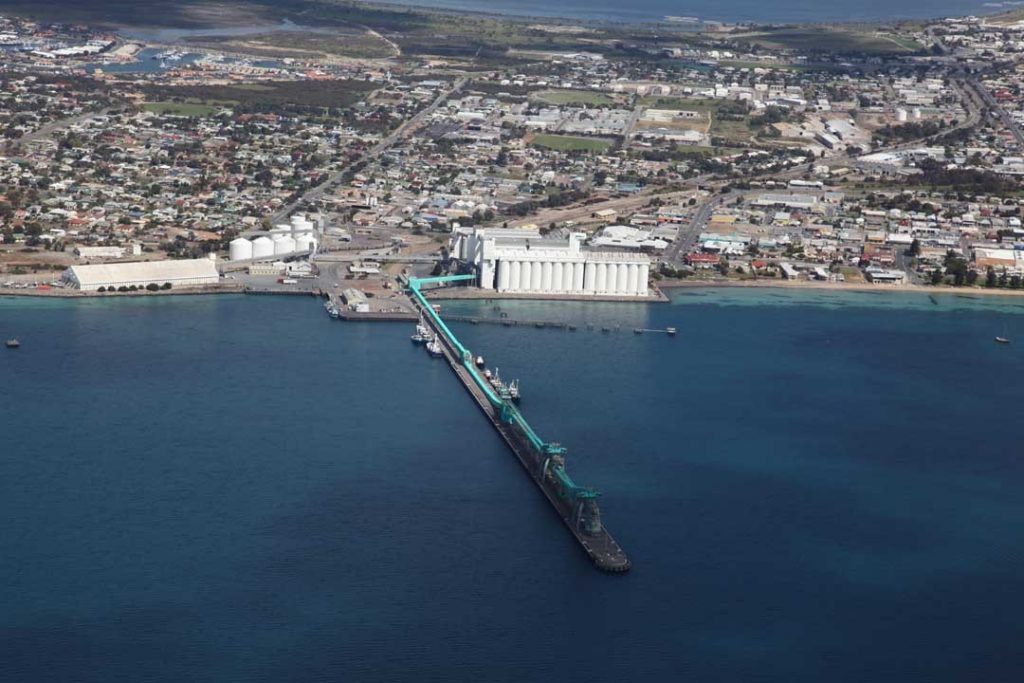
Image of Flinders Port Online of Wallaroo, SA
Exotic Wallaroo aside, there is a mood of change in the community about the benefits of government intervention to deliver items such as integrated transport terminals, affordable housing as well as protection of heritage and bushland habitats.
This enthusiasm for a national urban and regional agenda for Australia is shared by former Prime Minister Paul Keating whose model for future national investment funds is linked to the legislative mandate given to the Reserve Bank of Australia:
Australia’s economy needs an injection of public works spending to soften the blow of plunging resources investment and lacklustre spending by companies, former Prime Minister Paul Keating says.
If he were leading the country today, Mr Keating said on Friday he would establish a body to get major infrastructure projects off the ground and funded by the public and private sectors.
A key drag on economic growth in recent years has been the sharp slowdown in mining investment, which jumped from 2 per cent of gross domestic product to 8 per cent between 2006 and 2012, but has since retracted, Mr Keating noted.
The Queensland Labor Government already works across the political divide with Brisbane City’s LNP Council (BCC) as a key partner in implementing SEQPlan. BCC is anticipating 233,400 new dwellings by 2041. An overwhelming 94 per cent of these dwellings will be through urban infill compatible with forms of land use.
This has not stopped political debate about the BCC’s pro-development agenda. There is still mutual respect about legitimate spheres of influence between the two levels of government.
LNP Lord Mayor Graham Quirk distanced himself from the federal LNP to co-operate with the state government’s proposed cross-river rail link prior to the state election on 30 November 2017:
Lord Mayor Graham Quirk said the business case for Brisbane Metro, released last week, confirms the project is a cost-effective solution that unlocks the potential of the existing busway infrastructure and lays the foundation for future growth.
“Right now, buses carry two of every three public transport patrons in Brisbane. Our existing bus infrastructure is already at capacity in a number of areas and cannot cope with the continued forecast growth of our city,” he said.
“Brisbane Metro will provide significant benefits for both the city and the region, complementing the Cross-River Rail project and existing heavy rail services.
“Connecting Brisbane shows how Brisbane Metro will be part of a long-term plan for a broader metro network as extensions are made to the busway network and will be integrated with Cross River Rail and other existing rail.
“The proposed modern, high-frequency mass transit system will connect people to where they want to go and at the times they want to travel.”
The reforms will pave the way for future extension and improvement of the network, particularly in linking the identified growth corridors and areas.
Connecting Brisbane’s plan is consistent with the federal government’s Smart Cities Plan to support productive, accessible, liveable cities that attract talent, encourage innovation, and create jobs and growth.
In contrast to this inter-government co-operation in Brisbane, the innovative financial policy base of the Turnbull Government in searching for alternative forms of funding to assist with more progressive urban and regional planning in Metro Brisbane are difficult to find.
Perhaps Paul Keating is now needed on a more flexible urban and regional action team, which does not carry old ideological barriers from both the left and right of Australian politics.
These ideological blind spots continue despite the inclusion of new infrastructure portfolios in the current LNP Ministry with the goodwill of Prime Minister Turnbull himself.
As the new Deputy Prime Minister and Federal Minister for Infrastructure and Transport, The Hon Michael McCormack MP, presides over a strongly motor transport agenda for cities. Dr John McVeigh, Minister for Regional Development, Territories and Local Government, shares this.
Paul Fletcher as Minister for Urban Infrastructure and Cities is the only member of the federal infrastructure team to represent a metropolitan electorate. Assistant Minister Keith Pitt represents the regional Queensland electorate of Hinkler. He is an ardent supporter of the roads agenda of the federal LNP.
The local electorates of all the LNP infrastructure ministers seem to be well satisfied with the Turnbull Government’s roads agenda with commitment to the Inland Railway from Melbourne to the vicinity of the Port of Brisbane as a populist caveat. It appears to offer some proof of genuine commitment to rail transport options through the Australian Rail Track Corporation (ARTC). The Abbott Government once wanted to sell the ARTC to a multinational freight provider. There was no quest for a more inclusive funding model under the Turnbull Government.
The outcomes of the federal LNP’s rail infrastructure agendas are hardly inspirational.
The Inland Railway will not carry passengers, even to large cities like Toowoomba. It is on the route of a potential high speed rail connection to Brisbane. However, the design of the new Top of the Range rail freight tunnel does not have high enough safety standards for passenger rail services. There is no parallel rail access for the second Range Crossing for motor vehicles.
The main terminus of the Inland Railway will be the ultimate anti-climax. This is an inter-modal rail-road transport hub at Bromelton near Beaudesert, some 80 kilometres from the Port of Brisbane. From here, there is a now seldom utilized single standard gauge track to the Port of Brisbane. This was funded by Paul Keating’s Working Nation Programme.
There are no plans for federal funding of to upgrade rail tracks from this periphery of Brisbane on the Beaudesert-Jimboomba-Acacia Ridge Corridor along the under-utilized Interstate Railway from Brisbane to Sydney.
Narrow gauge tracks on parts of the Port of Brisbane line are regularly used for rail freight of coal from the Western Darling Downs through Ipswich to Brisbane’s south-side suburbs. Regular electrified passenger rail services on the Corinda to Yerongpilly line have been terminated to make way for the coal traffic.
Minister Fletcher’s launch of the Australia Future Cities Paper at the Sofitel Hotel in Melborune made a strong and commendable rhetorical commitment to sustainable cities with an emphasis on the benefits of Transport Oriented Developments (TODs) in such prime inner-suburbs that rattle to the sound of regular coal freight trains.
There is scant evidence of major financial commitments to urban and regional planning which are easily dismissed state or territory priorities.
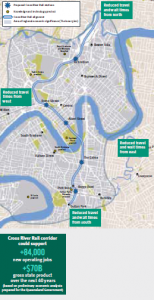 Concentrating more housing and commercial development near transport-oriented developments (TODs) could fit well into a progressive economic agenda from a new generation of LNP leaders.
Concentrating more housing and commercial development near transport-oriented developments (TODs) could fit well into a progressive economic agenda from a new generation of LNP leaders.
In the interim, state/territory and local governments are largely at the mercy of pro-development corporate agendas.
ShapingSEQ Plan is still inviting more than the optimum levels of greenfield developments in some of the twelve local authorities where the development industry has a strong impact on local politics to campaign for the re-election of pro-development civic leaders.
This pro-development perspective is a dream come true for the house and garden mentality of yester-year with disastrous ecological consequences. Beyond the Noosa to the Gold Coast Corridor which includes the City of Brisbane, half of the region’s local authorities are letting down the goals of ShapingSEQ Plan by an overgenerous commitment to greenfield developments which involve more tree clearing and loss of habitats.
Sixty per cent of the projected 907,200 new dwellings will be from urban infill thanks largely to the urban planning commitments of the City of Brisbane, the Gold Coast, Redlands and the Sunshine Coast.
The state-funded Cross River Rail Project is vital to the sustainable transformation of urban infill projects. The Queensland Government (QG) is looking to alternative forms of finance to fast-track the cross-river project.
Under its accountable tendering system, a Department of Main Roads Company (QConnect) will compete for the construction project with funding support from the Queensland Investment Corporation (QIC).
More reliance on varying degrees of such public-private partnerships can assist with the delivery of essential infrastructure through the pragmatic use of investment capture from Australian and overseas corporations through new National, State or Territory Investment Funds and even local government levels.
Brisbane’s LNP Council is already expanding the role of The City of Brisbane Investment Corporation (CBIC) which has doubled its asset base since 2008 to a current $273 million, plus the net delivery of $90 million in dividends to Council since 2009 (ABC News Online 20 March 2018).
While the Labor Opposition on the BCC has been critical of the mix of investments by the CBIC, there can still be agreement in principle on the positive benefits of such funds in the delivery of new infrastructure, community services and the application of research which could not be delivered by the corporate sector without some government assistance that uses investment capture to avoid new budget deficits.
Let’s take some examples from inner-city precincts in Brisbane of just what could be achieved through investment capture funds to supplement existing corporate investment.
Corporate Commitments to Urban Development in Brisbane and Their Limitations
Brisbane’s Southpoint Property Development is just one $600 million investment by the Anthony John Group across Australia. This impressive corporate project is adjacent to the Brisbane’s South Bank Precinct.
Welcome to the brand-new world of gleaming retail complexes, new age apartments, commendable efforts at heritage protection and new aesthetic balance in the layout of shops and services.
The Southpoint Project was a product of negotiations between the Southbank Corporation and the Anthony John Property Group in 2008. It is now operational and promoted by the Southbank Corporation:
Located at the southern end of Grey Street Southpoint is a $600 million mixed use master-planned development by the highly acclaimed Brisbane based developer Anthony John Group. It features three towers comprising 413 residential apartments, Brisbane’s second luxury boutique Emporium Hotel, A-Grade commercial office space and an estimated $40 million, 4,500sqm retail and dining plaza.
In October 2016, the first stage of the development was completed and comprises the centrally positioned 23,000 sqm Flight Centre commercial tower. The Flight Centre tower is the ASX-listed company’s consolidated global headquarters, housing over 2,000 employees.
A second tower located on the corner of Grey and Tribune Streets will boast a new flagship 142-suite Emporium Hotel, along with residential (Emporium Apartments and Emporium Residences), is being constructed by Hutchinson Builders and is scheduled for completion in mid-2018.
Southpoint is Brisbane’s most successful recent Transport Oriented Development (TOD). An escalator takes shoppers who want to use public transport directly to Platform One of the adjoining South Bank Train Station. It is proof of the capacity of the corporate sector to add life and vitality. However, much more could have been achieved through more commitment from government planning agencies through funding from an Urban Development Authority with the financial support from a Queensland Investment Fund.
Easier pedestrian access to the adjoining platform, the Translink Bus Terminal and the South Bank TAFE College could have been incorporated into the re-development with the addition of more commercial precincts and affordable housing space. These additions would come with a price-tag in the hundreds of millions that could bring additional dividends to the Urban Development Authority as add-ons to existing commercial priorities.
The consequences of neglect are evident in the Fortitude Valley in Brisbane.
Urban blight is evident of the fringes of the once thriving Fortitude Valley precinct. Multinational management firm Jones Lang La Salle (JLL) has done its best to revitalise the Fortitude Valley Station Precinct within the floor space under its control.
However, the covered walkway linking the Valley Metro to other parts of Fortitude Valley crosses through other corporate properties.
This was once a bustling transport-oriented development with popular department stores such as McWhirters, T.C Beirne and Walton Stores until the advent of suburban shopping centres in the 1960s.
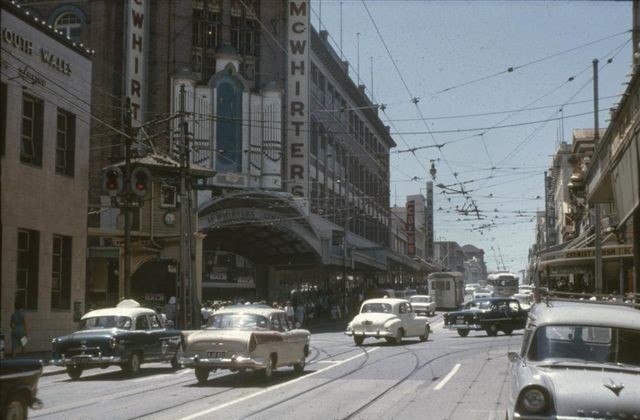
The Valley Corner Revisited 1968 Edition (Image from John Ellway Architect )
Nearby China Town and the Valley Night Club District soon gained a much higher profile. The latter featured prominently in the Fitzgerald Inquiry into police and political corruption which helped to end the hegemony of the state LNP in 1989.
This ageing but refurbished Metro Valley Centre could benefit from an association with a public sector Urban Renewal Authority to finance the acquisition of adjacent properties for incorporation into the Valley Metro Redevelopment Plan.
In a market economy, change can come slowly as property owners wait to maximise property gains from re-development offers. The old Thatcherite ideology which defends the complete autonomy of property-owners is a recipe for urban stagnation.
Support for redevelopment of the entire precinct comes from the Fortitude Valley Chamber of Commerce (Tony Moore in Brisbane Times, 7 July 2017):
Fortitude Valley’s Chamber of Commerce has called for the Queensland government to step in, so rail commuters did not have to walk through a dark corridor to access the suburb’s train station.
Bereft of light and power, with escalators from Wickham Street broken and boarded up, the disrepair has arisen from a long-running dispute between two property owners, Jack Moc and Chiu Fan Lee.
It was a situation that angered local business owners, who say the mess has had a negative impact on their commercial operations.
“(Business) is down 20 per cent. No one passes through here unless they have a reason to go past here anymore.”
Dr Hart, based at the Valley Metro shopping centre atop the train station, said people took to living on the disused escalators at one stage.
“They dug a hole through the wall and were living down the bottom there, because it is all sealed off,” he said.
Across the Wickham Street pedestrian bridge, in the McWhirter’s building, Hayley Hal from the Miss Mekong beauty salon said a man tried to grab her daughter in the blacked-out section of walkway near the train station.
Alarming Inner-City Trends in the USA
Fortunately, local government planning controls and modest levels of public sector commitments to infrastructure and community services have protected inner-city precincts in Brisbane from the excesses of market ideology in some US inner-city precincts:
This year 3,500 retail stores will be closing their doors. Big name companies like Macy’s, JC Penney and Sears are having a hard time staying open. With thousands of stores closing nationwide, this has caused hundreds of malls to do the same. Online shopping has taken over the way people consume … An indoor mall hasn’t been built in America since 2006 and that has forced existing malls to reinvent themselves. Some malls have added movie theatres, restaurants and bowling alleys.
While such generalized claims need to be more fully investigated, the extremes of US urban decay are a social reality. In St. Louis Missouri, progressive planners could have offered add-ons like bus terminals, airport shuttle terminals, more extensive light rail links, innovative retailing and affordable inner-city housing to the under-utilized Union Station complex.
Under market ideology, urban decay in such inner-city precincts is justified by trickle-down effects of new investment in commercial projects and e-commerce in outer-suburban areas where location costs are lower.
St. Louis has its new Amazon-leased Warehouse Facility by Interstate 470. It carries the Orwellian name of Fulfillment Centre. The locality name of St Peters has a touch of irony. There is little that is inspirational in an automated warehouse complex with its maze of conveyor belts and robotic processes that contribute to the functional goals of least cost despatch and delivery (St Louis Post-Despatch Online 8 March 2018).
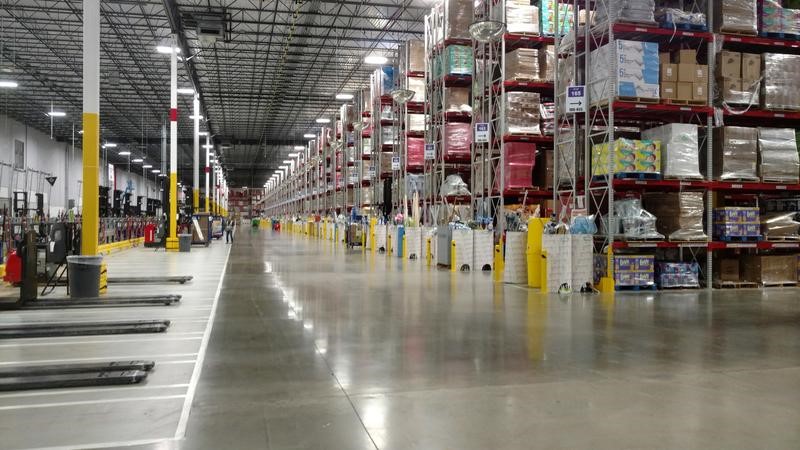
Image: St. Louis Public Radio Online: St. Peters will be the home of the first fulfilment centre in Missouri. The company already has two large warehouses in Edwardsville, Illinois, one of which is pictured here.
Perhaps a new generation of architects and town planners will want to challenge the transfer of such aggressively corporate goals to Australia as part of the current federal LNP hype about the enduring value of corporate property rights that are compatible with old market ideology repackaged with new rhetorical flair.
The old divide between the benefits of so-called free enterprise and government planning is now dated. As global share markets become highly volatile, it is time for Labor to renew its political outreach on issues relating to urban and regional development.
The evidence from the back streets of St. Louis, Missouri and its alienated outer suburbs, do suggest that persistence of the old National Party model would be disastrous to our society and to our national identity as a progressive multicultural society.
Let’s build more sustainable futures with goodwill from householders, business and government that were evident in the hey-day of the Fortitude Valley Junction in Brisbane. It was not such a bad Transport Oriented Model (TOD) in retrospect if commitment to market ideology did not have such a hegemony in those far-off times.
The state LNP’s plans for a more motorized Brisbane were based on partisan advice from US engineering consultants like Ford Bacon & Davis and then Wilbur Smith Associates who continue to export the American Way in traffic engineering into the new century as SEQ bears the ugly scars of Brisbane’s Riverside Expressway.
 Denis Bright (pictured) is a registered teacher and a member of the Media, Entertainment and Arts Alliance (MEAA). Denis has recent postgraduate qualifications in journalism, public policy and international relations. He is interested in advancing pragmatic public policies that are compatible with contemporary globalization.
Denis Bright (pictured) is a registered teacher and a member of the Media, Entertainment and Arts Alliance (MEAA). Denis has recent postgraduate qualifications in journalism, public policy and international relations. He is interested in advancing pragmatic public policies that are compatible with contemporary globalization.









10 comments
Login here Register here-
Nora -
Lilly -
Chris -
Stella -
Pat -
Raise the Standard -
Paul Bright -
Theresa__M -
James Robo -
Mia
Return to home pageWe need progressive alternatives for cities and regions trashed by urban sprawl. And we need to get these talked about now because it takes a long time for implementation.
You only have to drive in the daily gridlock on your way to & from work to realise the current situation is not sustainable
We need to employ the best mids we can afford to plan our future transport options & roads based on future population predictions
The current situation is way too expensive for the economy and work life balance
The strategy needs to involve all aspects of transport and everything linked to run smoothly in a timely fashion
Overseas investment in these new funds can and should deliver new independence to our national and state governments.
Denis, thanks for your article on urban planning and the important role of public private partnerships in building infrastructure.
Lily, I agree – there has to be a better solution than sitting in gridlock day and night – this should be a priority of all tiers of government. Looking forward to a more sustainable future.
Local politics in some areas of the SEQ Plan has been tainted by donations from developers. Here is the latest news item:
http://www.abc.net.au/news/2018-03-26/logan-city-mayor-luke-smith-by-crime-and-corruption-commission/9586872
Such events make this article very topical. New controls against such potential political corruption are required 30 years after the Fitzgerald Inquiry.
Thanks for the article Denis!
Now is a perfect opportunity for the federal govt to invest in long term functional and valuable infrastructure for a cities and regional towns.
Let’s rethink our design and funding models. Let’s also factor community well being into our decision criteria.
Let’s do this Australia!
ABC Four Corners recently ran ‘Big Australia – Are we ready’ which investigated population growth in Australia’s major cities. With the substantial population growth projected in Australia’s major cities such as Melbourne, Sydney, Perth & Brisbane, the need to up our game on the planning and infrastructure delivery is critical. It’s time to think outside the box and investigate different ways of approaching funding models.
There are some great outcomes being delivered throughout our cities such as Southpoint and many others. However, with our cities expanding, there is a need for the delivery of sustainable transport infrastructure. This needs to put higher on the agenda!
Efficient public transport needs to be incorporated into any new projects before they are given the green light. It’s not much use to anyone if these areas are going to result in many more cars clogging up the roads and make it difficult for everyone on their daily commute.